INSTRUCTION MANUAL
GUIDE D’UTILISATION
MANUAL DE INSTRUCCIONES
DW328
Variable Speed Portable Band Saw
Scies à ruban portatives de vitesse variable
Sierras de banda portátiles de la velocidad variable
INSTRUCTIVO DE OPERACIÓN, CENTROS DE SERVICIO Y PÓLIZA
DE GARANTÍA. ADVERTENCIA: LÉASE ESTE INSTRUCTIVO ANTES
DE USAR EL PRODUCTO.
DEWALT Industrial Tool Co., 701 East Joppa Road, Baltimore, MD 21286
(JUL06) Form No. 640273-00 DW328 Copyright © 2006 DEWALT
The following are trademarks for one or more DEWALT power tools: the yellow and black color scheme;
the “D” shaped air intake grill; the array of pyramids on the handgrip; the kit box configuration; and the
array of lozenge-shaped humps on the surface of the tool.
IF YOU HAVE ANY QUESTIONS OR COMMENTS ABOUT THIS OR ANY DEWALT TOOL,
CALL US TOLL FREE AT: 1-800-4-DEWALT (1-800-433-9258)
General Safety Instructions
WARNING! Read and understand all instructions. Failure to follow all
instructions listed below may result in electric shock, fire and/or serious
personal injury.
SAVE THESE INSTRUCTIONS
WORK AREA
• Keep your work area clean and well lit. Cluttered benches and dark areas invite
accidents.
• Do not operate power tools in explosive atmospheres, such as in the presence of
flammable liquids, gases, or dust. Power tools create sparks which may ignite the dust
or fumes.
• Keep bystanders, children, and visitors away while operating a power tool.
Distractions can cause you to lose control.
ELECTRICAL SAFETY
• Grounded tools must be plugged into an outlet properly installed and grounded in
accordance with all codes and ordinances. Never remove the grounding prong or
modify the plug in any way. Do not use any adaptor plugs. Check with a qualified
electrician if you are in doubt as to whether the outlet is properly grounded. If the
tools should electrically malfunction or break down, grounding provides a low resistance
path to carry electricity away from the user.
• Avoid body contact with grounded surfaces such as pipes, radiators, ranges and
refrigerators. There is an increased risk of electric shock if your body is grounded.
• Don’t expose power tools to rain or wet conditions. Water entering a power tool will
increase the risk of electric shock.
• Do not abuse the cord. Never use the cord to carry the tools or pull the plug from
an outlet. Keep cord away from heat, oil, sharp edges or moving parts. Replace
damaged cords immediately. Damaged cords increase the risk of electric shock.
• When operating a power tool outside, use an outdoor extension cord marked
“W-A” or “W.” These cords are rated for outdoor use and reduce the risk of electric
shock. When using an extension cord, be sure to use one heavy enough to carry the
current your product will draw. An undersized cord will cause a drop in line voltage
resulting in loss of power and overheating. The following table shows the correct size to
use depending on cord length and nameplate ampere rating. If in doubt, use the next
heavier gage. The smaller the gage number, the heavier the cord.
Minimum Gage for Cord Sets
Volts Total Length of Cord in Feet
120V 0-25 26-50 51-100 101-150
240V 0-50 51-100 101-200 201-300
Ampere Rating
More Not more AWG
Than Than
0-6 18 16 16 14
6 - 10 18 16 14 12
PERSONAL SAFETY
• Stay alert, watch what you are doing and use common sense when operating a
power tool. Do not use tool while tired or under the influence of drugs, alcohol, or
medication. A moment of inattention while operating power tools may result in serious
personal injury.
• Dress properly. Do not wear loose clothing or jewelry. Contain long hair. Keep
your hair, clothing, and gloves away from moving parts. Loose clothing, jewelry, or
long hair can be caught in moving parts. Air vents often cover moving parts and should
also be avoided.
• Avoid accidental starting. Be sure switch is off before plugging in. Carrying tools
with your finger on the switch or plugging in tools that have the switch on invites
accidents.
• Remove adjusting keys or wrenches before turning the tool on. A wrench or a key
that is left attached to a rotating part of the tool may result in personal injury.
• Do not overreach. Keep proper footing and balance at all times. Proper footing and
balance enables better control of the tool in unexpected situations.
• Use safety equipment. Always wear eye protection. Dust mask, non-skid safety shoes,
hard hat, or hearing protection must be used for appropriate conditions.
TOOL USE AND CARE
• Use clamps or other practical way to secure and support the workpiece to a stable
platform. Holding the work by hand or against your body is unstable and may lead to loss
of control.
• Do not force tool. Use the correct tool for your application. The correct tool will do the
job better and safer at the rate for which it is designed.
• Do not use tool if switch does not turn it on or off. Any tool that cannot be controlled
with the switch is dangerous and must be repaired.
• Disconnect the plug from the power source before making any adjustments,
changing accessories, or storing the tool. Such preventative safety measures reduce
the risk of starting the tool accidentally.
• Store idle tools out of reach of children and other untrained persons. Tools are
dangerous in the hands of untrained users.
• Maintain tools with care. Keep cutting tools sharp and clean. Properly maintained
tools, with sharp cutting edges are less likely to bind and are easier to control.
• Check for misalignment or binding of moving parts, breakage of parts, and any
other condition that may affect the tool’s operation. If damaged, have the tool
serviced before using. Many accidents are caused by poorly maintained tools.
• Use only accessories that are recommended by the manufacturer for your model.
Accessories that may be suitable for one tool, may become hazardous when used on
another tool.
SERVICE
• Tool service must be performed only by qualified repair personnel. Service or main-
tenance performed by unqualified personnel could result in a risk of injury.
• When servicing a tool, use only identical replacement parts. Follow instructions in
the Maintenance section of this manual. Use of unauthorized parts or failure to follow
maintenance instructions may create a risk of electric shock or injury.
Additional Safety Rules for Portable Band Saws
• Hold tool by insulated gripping surfaces when performing an operation where the
cutting tool may contact hidden wiring. Contact with a “live” wire will make exposed
metal parts of the tool “live” and shock the operator.
• Keep hands away from cutting area and blade. Keep one hand on the main handle
and the other hand on the front handle to prevent loss of control which could result in
personal injury.
• Always make sure the portable band saw is clean before using.
• Always cease operation at once if you notice any abnormality whatsoever.
• Always be sure all components are mounted properly and securely before using tool.
• Always handle the band saw blade with care when mounting or removing it.
• Always keep your hands out of the line of the band saw blade.
• Always wait until the motor has reached full speed before starting a cut.
• Always keep handles dry, clean, and free of oil and grease. Hold the tool firmly when in
use.
• Always be alert at all times, especially during repetitive, monotonous operations. Always
be sure of position of your hands relative to the blade.
• Never remove material guide/work stop.
• Stay clear of end pieces that may fall after cutting off. They may be hot, sharp and/or
heavy. Serious personal injury may result.
WARNING: DO NOT modify and/or use this tool for any application other than for which
it was designed.
WARNING: Shock Hazard. Exercise extreme caution when cutting blind into conduit and
pipe. Be sure the object being cut does not contain electrical wires, gases, or water, etc.,
which could create hazardous conditions causing personal injury and property damage.
WARNING: Some dust created by power sanding, sawing, grinding, drilling, and other
construction activities contains chemicals known to cause cancer, birth defects or other
reproductive harm. Some examples of these chemicals are:
• lead from lead-based paints,
• crystalline silica from bricks and cement and other masonry products, and
• arsenic and chromium from chemically-treated lumber (CCA).
Your risk from these exposures varies, depending on how often you do this type of work. To
reduce your exposure to these chemicals: work in a well ventilated area, and work with
approved safety equipment, such as those dust masks that are specially designed to filter out
microscopic particles.
• Avoid prolonged contact with dust from power sanding, sawing, grinding, drilling,
and other construction activities. Wear protective clothing and wash exposed areas
with soap and water. Allowing dust to get into your mouth, eyes, or lay on the skin may
promote absorption of harmful chemicals.
WARNING: Use of this tool can generate and/or disburse dust, which may cause serious
and permanent respiratory or other injury. Always use NIOSH/OSHA approved respiratory
protection appropriate for the dust exposure. Direct particles away from face and body.
• The label on your tool may include the following symbols. The symbols and their defini-
tions are as follows:
V ............volts A................amperes
Hz ..........hertz W ..............watts
min..........minutes ............alternating current
........direct current
n
o ..............no load speed
............Class I Construction ..............earthing terminal
................(grounded) ..............safety alert symbol
............Class II Construction …/min........revolutions or reciprocation
................(double insulated) ..................per minute
sfpm ........surface feet per minute
SAVE THESE INSTRUCTIONS
COMPONENTS (FIG. 1, 2)
A. Auxiliary handle I. Speed wheel
B. Lock button J. Blade
C. Trigger switch K. Rubber tires
D. Main handle L. Pulley
E. Material guide/Work stop M. Blade guard
F. Guide rollers
G. Blade tracking adjustment
H. Blade tension lever
ASSEMBLY
Blades
This portable band saw is setup for use with .020" (0.5 mm) thick, 1/2" (12.5 mm) wide
and 44-7/8" (1140 mm) long blades. To use .025 (.64 mm) thick blades, please contact an
authorized D
EWALT service center.
WARNING: The use of any other blade or accessory might be hazardous. DO NOT use
any other type of accessory with your band saw. Blades used on stationary band saws are
of different thickness. Do not attempt to use them on your portable unit.
Blade Selection
In general, first consider the size and shape of the work, and the type of material to be cut.
Remember, for the most efficient cutting, the coarsest tooth blade possible should be used in
a given application, because the coarser the tooth, the faster the cut. In selecting the appro-
priate number of teeth per inch of the band saw blade, at least two teeth should contact the
work surface when the blade is rested against the workpiece. As a rule of thumb, soft materi-
als usually require coarse tooth blades, while hard materials require fine tooth blades. Where
a smoother finish is important, select one of the finer tooth blades.
Select the appropriate band saw blade according to the material type, dimensions, and num-
ber of teeth. See Blade Description chart.
CAUTION: The following table is intended as a general guide only. Determine the type of
material and dimension of the workpiece and select the most appropriate band saw blade.
Incorrect blade application may result in loss of control causing personl injury.
If you have questions or comments, contact us.
Pour toute question ou tout commentaire, nous contacter.
Si tiene dudas o comentarios, contáctenos.
1-800-4-DEWALT • www.dewalt.com

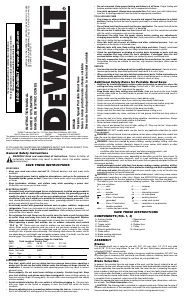


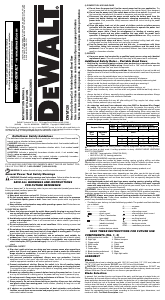
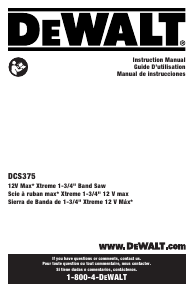
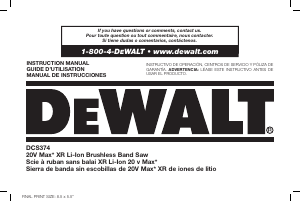
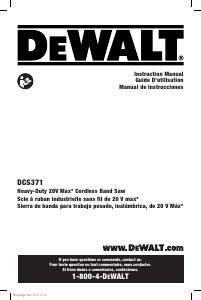

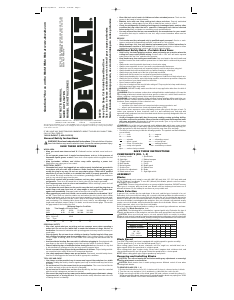
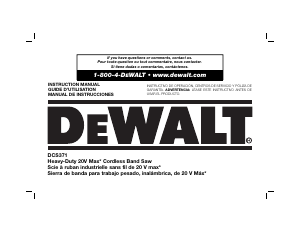
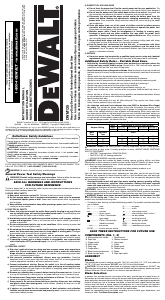
Praat mee over dit product
Laat hier weten wat jij vindt van de DeWalt DW328 Bandzaag. Als je een vraag hebt, lees dan eerst zorgvuldig de handleiding door. Een handleiding aanvragen kan via ons contactformulier.